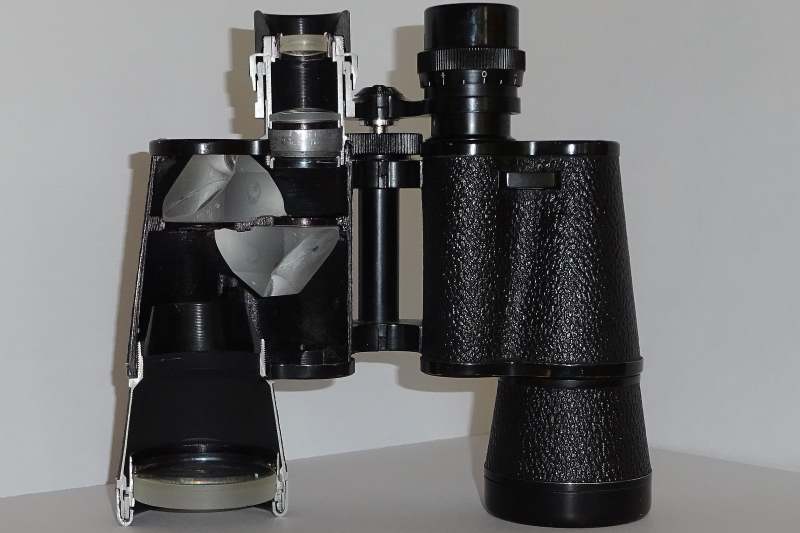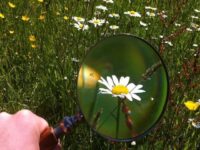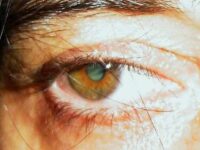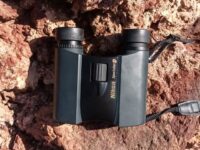Binoculars work on the basis of optical laws, precisely by taking advantage of the properties and the behavior of light as it travels through different media. Let’s take one apart to see how binoculars work, what the essential parts of binoculars are, and how they work together.
How Do Binoculars work
Binoculars magnify an observed image with the help of a system of lenses (objective and ocular lens). Prisms reverse the inverted images of the lenses and reduce the length of the binoculars by redirecting the light path.
Binoculars need three optical parts to work:
- Eyepiece or Ocular: to focus on and enlarge the projected virtual image
- Prisms: to correct the image orientation – flip the image vertically and horizontally
- Objective Lens: collects incident light and concentrates it in the focal point, usually a lens system of 2 or more lenses to compensate for aberration
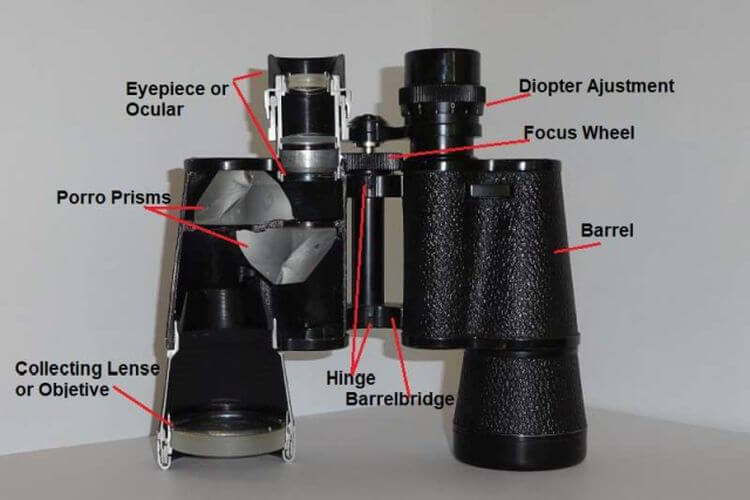
The construction of the binoculars is easily explained
To understand the parts of binoculars and their functions, it is best to disassemble the binoculars into their individual parts. There is an optical system and a mechanical system to look at.
Optical Parts Of Binoculars
Binoculars consist of three optical components that refract and focus light to enlarge a distant object and make it appear closer. These three essential components are the objective lens, prism system, and eyepiece. Let’s take a closer look at these parts to understand their functions and how binoculars magnify.
Objective lens
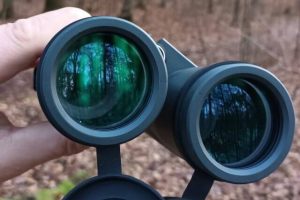 The objective with its large collection lens is located at the front end or the bottom end of the binoculars, depending on how you look at it. The collection lens is aimed at the object of interest, it captures the light.
The objective with its large collection lens is located at the front end or the bottom end of the binoculars, depending on how you look at it. The collection lens is aimed at the object of interest, it captures the light.
The larger the aperture – the diameter of the lens, the more light-gathering power the binoculars have, thus the brighter the image will appear. For this reason, hunters or stargazing enthusiasts choose binoculars with large lens diameters. Lightweight compact binoculars that are great for hiking or occasional use may have a much smaller aperture of around 25 mm. The size of the aperture is expressed in the second number of the binoculars rating ie. 8x42
The image, which is projected by the objective lens is upside down and mirrored. To correct this, the prisms are used inside the binoculars.
The prism system
The prisms are made of crown glass and serve as correcting mirrors. They have the function to flip the upside-down and mirrored image from the objective lens, so we can see a normal-looking picture.
Two prism designs are commonly used in binoculars, we distinguish between Porro prism and roof prism binoculars.
Porro prisms
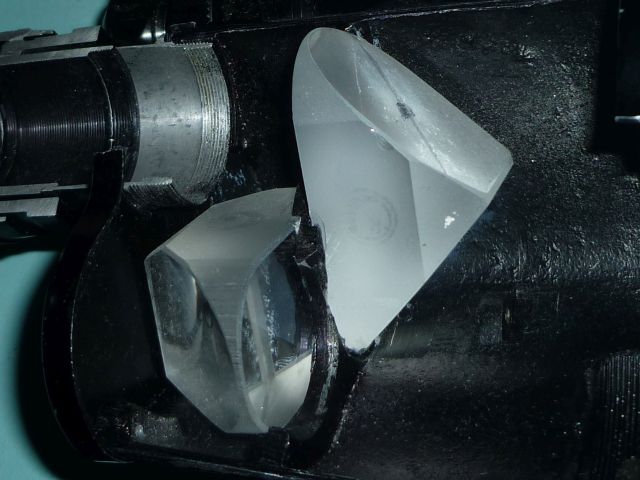
There are two prisms used in Porro prism binoculars, they are set up at right angles to each other. The light rays are reflected by the internal surfaces and inverted from top to bottom in one prism and from left to right in the other prism.
The advantage of binoculars with a Porro prism system is that these prisms are much easier and cheaper to manufacture and require little space as they are set up next to each other. Porro prism binoculars are often of shorter build than roof prism binoculars.
Roof prism
This prism system usually consists of two prisms, of which at least one has the shape of a roof edge.

Roof prisms allow much slimmer, more compact binoculars. This may be the reason why roof prism binoculars have become very popular. Sales and marketing measures from the industry not to forget.
Binoculars with rooftop prisms are a bit narrower and more elegant compared to models with Porro prisms but are usually a bit more expensive since a more elaborate production is required. The image correction in roof prism binoculars may follow a more complex beam path than in Porro’s, but the result of flipping the upside-down and mirrored image from the objective lens is the same.
Eyepieces
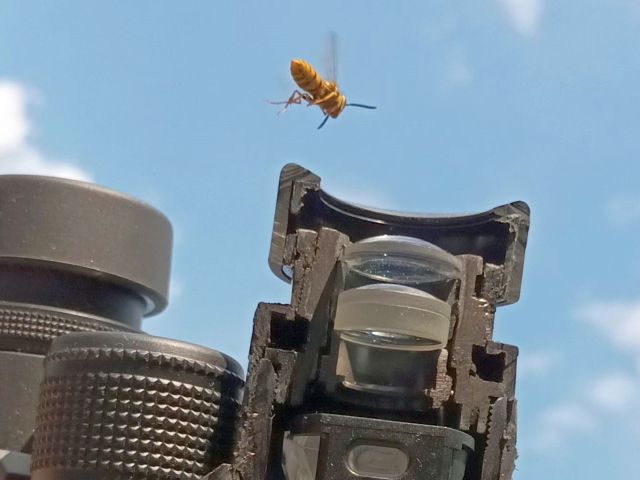 The eyepieces, also called ocular, are located at the front of the binoculars and are the two lenses that we look directly into during observation.
The eyepieces, also called ocular, are located at the front of the binoculars and are the two lenses that we look directly into during observation.
Eyecups (rubber extensions on the ocular barrel) are often used to keep the correct eye distance to the eyepiece and provide some protection from disturbing infalling stray light
The eyepiece usually consists of two or more lenses. When the binoculars are properly focused, it allows the human eye to see the image that’s projected by the objective lens and the prism system.
Mechanical Parts of Binoculars
Diopter Adjustment
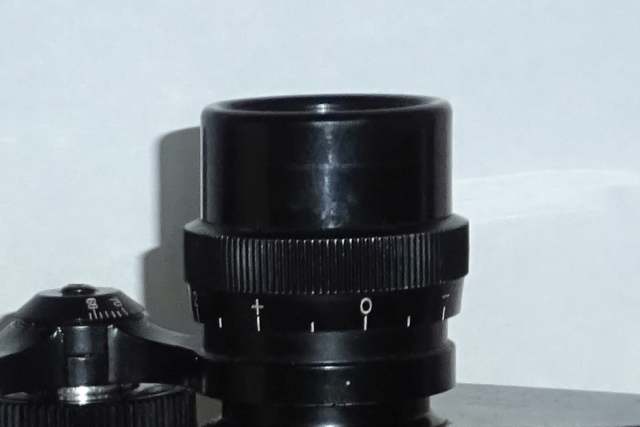
Many people do not have the same strength eyesight on both eyes. To allow for fatigue-free observation through binoculars the different eyesight must be compensated so both eyes can see a focused image.
Usually, the right eyepiece can be fine-tuned and to compensate for the dioptric difference by adjusting the focus of the ocular lenses.
To adjust, close your right eye and focus in on an object using the left eye (the eyepiece without diopter compensation) by turning the Center Focus Wheel until the image is sharp and clear. Then fine adjust the sharpness on the second eyepiece with the aid of the Diopter Adjustment.
Focus Wheel
To get a sharp and clear image when viewing objects in different distances it is always necessary to adjust the focus of the binoculars. Turning the focus knob (or focus wheel) will push out or pull in the eyepieces (or just one of the eyepiece lenses) so the focal point of the eyepieces converges with the focal point of the objective lens.
Barrel-bridge with Hinge
Binoculars are simply two telescopes that are mounted next to each other. They need to point exactly in the same direction to allow an observer to see simultaneously through them. The barrel-bridge holds the binoculars barrels in parallel alignment to each other so the optical axis is parallel (the light beam is collimated).
Hinges that join the bridge allow us to adjust the distance of the eyepieces to the viewer’s individual eye distance.
Barrel or Tube
The barrel is the housing that holds all the optical parts together. The housing protects the optical components and holds them in a stable position so they don’t shift from mechanical shock or when dropped.
Many of the better binoculars have barrels and housing, O-Ring sealed to keep water and moisture out. Some even purge the inside with noble gas to guarantee water tightness even when submerged.
Path of Light in Porro Prism Binoculars
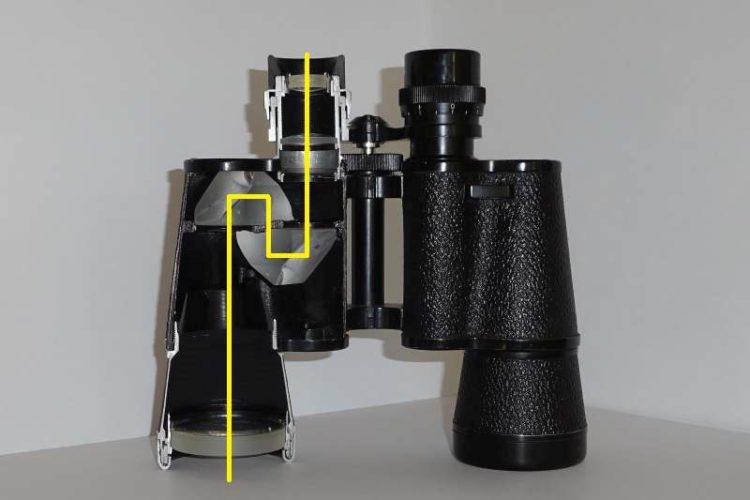
How Prisms Invert the Image
- The image from the viewed Object appears horizontally and vertically inverted
- The first prism inverts the image vertically
- The second prism inverts the image horizontally
- A small image is projected at the end of the focal length of the objective
- The ocular magnifies the image and presents it to the eye
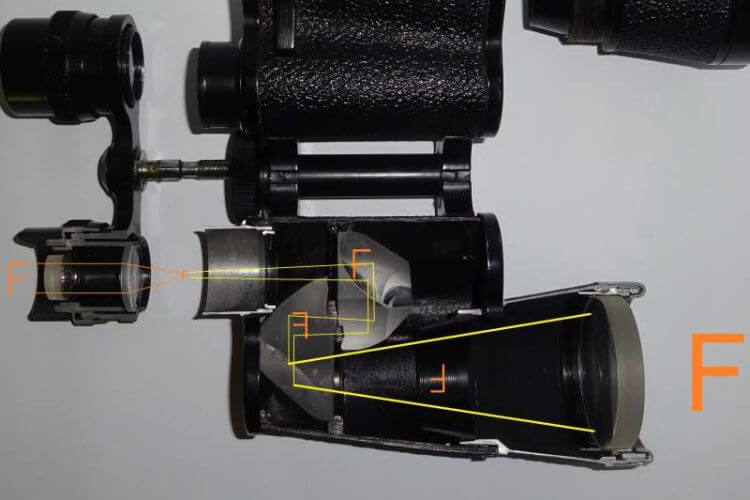
How the image gets into Focus
To present a focused and sharp image to the viewer, the focal point of the ocular lens must converge with the focal point of the objective lens.

How to Calculate the Binoculars Magnification
The Magnification, or sometimes called the “Power” of binoculars is an important rating factor for most users. It indicates how many times an image appears magnified when viewed through binoculars compared to being viewed with the bare eye.
The magnification number is the quotient of the lens focal length and eyepiece focal length. In the example above it would be 240 / 24 = 10
Binocular magnification is expressed in the first number of the binocular rating ie. 8x42
The most popular magnification factors are 8x and 10x. At 10x magnification, objects 100 meters away appear as if they were 10 meters away.
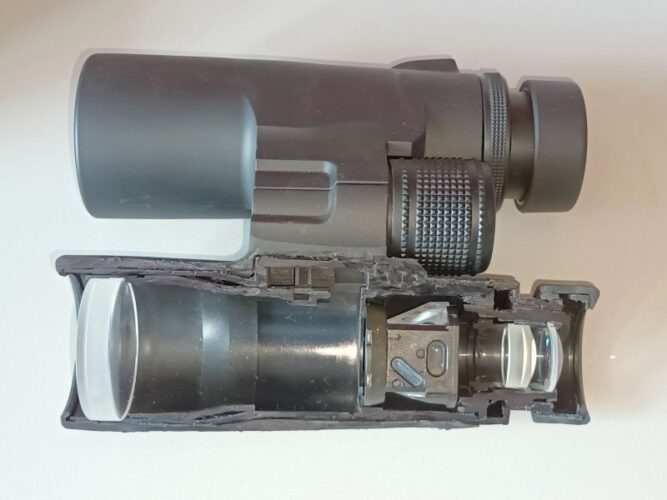
Summary Binoculars Parts And Their Function
Binoculars are made of three optical parts: Eyepieces, Prisms, and Objective Lens. A look at these parts reveals how do binoculars work.
The Objective lens is the large lens at the front end of the binoculars, it faces the viewed object. The diameter of the objective lens is called the aperture. The size of the lens determines the resolution (sharpness) and how much light can be gathered. The captured image from the objective is mirrored and upside down.
Prisms are used to correct the image. The inverted image light beam passes through the prisms is mirrored on the internal faces of the prism and exits as a normal true looking image. The two prism systems used are Porro prisms and roof prisms.
The Ocular, or eyepiece, is what the viewer looks into. The image that the objective lens has collected and projected at the end of its focal length, is magnified by the eyepiece and presented to the viewer’s eye.
